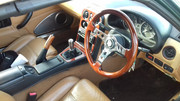Yes, generally speaking early versions of GDI did have widespread issues with this. The primary causes are the engine ingesting it’s own exhaust and blow-by gasses, along with everything else they hold.
It was however remedied and current models have no issues. (utilising two injectors per cylinder was one way around it, the second set being back in the traditional position).
What the Skyactive does to circumnavigate this problem I have no idea, but if it were an issue and I was a long term owner I would be seeking to stop the causes.
Increasing efficiency means power output goes up as does MPG. If an engine is specified correctly then both should be available together, not just one or the other.
I don’t believe ND has fixed the issue. I think crud buildup on inlet is an issue.
There was a day when life was simple.
Quick squirt of cleaner on the MAF wire every other decade, fresh NGK’s & leads…job.

Well it’ll give us something to do in the future when we’ve got less NC engines to rebuild and replace ![]()
Is there empirical evidence to support this? The USA was going crazy for ‘catch cans’ and ‘walnut shell blasting the port’ theories in the early days of the ND and that seems to have mostly faded away. A German publication or institute (can’t remember which) has done a high mileage skyactive-g stripdown that didn’t show any evidence of build-up.
Miata.net is a useful resource.
Exactly.
This all very interesting stuff regarding direct injection and Atkinson cycle technology. It has been suggested that the problems with my ND Super 220’s performance and smoothness are a result of excessive carbon build up. A cursory inspection using an endoscope down the spark plug holes by myself suggest either excessive carbon build up or detonation damage. Which of these two it is, has yet to be confirmed. My car has only done 15K miles so if it is carbon build up this surely cannot be normal?
Would not the fact that the engine runs an Atkinson cycle tend to ameliorate this inlet valve carbonisation problem, as in the Atkinson cycle the inlet valves are left open for a period during the compression stroke, forcing unburnt fuel/air mixture back up the inlet tracts thereby cleaning the inlet valve/inlet manifold areas?
The endoscope inspection I used did not allow me to inspect the valves, but there is clearly something going on, on the piston crowns.
I have said it before and I will say it again. If I were to try get more power from the ND engine I would disable all hybrid engine cycles from the ECU. The engine is highly tuned and works very efficiently as stock. Trying to get more out of the thing as a NA engine is IMHO extremely hard or trying to find unicorns.
Now the engine runs NA at a very high compression ratio (14:1) and generally speaking if you were to turbo the thing you don’t particularly want high compression ratio because of the risk of autoignition. Turbo engines generally need around 8 - 9 :1 range compression ratio. The car already has some sensors but they are calibrated for the NA engine and no tuner to my knowledge has either the experience or the capability to do the R&D required to make use of the hardware on the car.
All you do with the turbo is that you chuck more charge air and more fuel and you can achieve a higher bang. IMHO your issue is the compression ratio so if you want to use that engine you want to change pistons (which makes no practical sense imho)
Sorry but I am not sure what you are getting at. The BBR Super 220 ND is not a turbo conversion, so no piston changes are required to reduce the compression ratio. The standard gearbox would not take the torque generated by a turbo. The conversion in effect improves the breathing at high revs increasing the torque and hence the power with only small increase in the maximum torque. The modifications include camshafts, stronger valve springs, cold air intake and exhaust system improvements. I think that BBR may do a turbo version but that includes different pistons, stronger conrods and an adapter plate to use the NC gearbox which is stronger than the ND one.
I see my apologies, I may have mixed that up with the BBR 225 which is a turbo but for the nc.
My statement about the hybrid engine cycles from the ECU is still valid though. The engine is highly tuned and works very efficiently as stock because of that. Trying to get more out of the thing as a NA engine is IMHO extremely hard and I’m not surprised that people have issues.
You can get more power from higher rpm and I think that is the main source of the increase in bhp. So if you never use over 7000 rpm you won’t see much of it.
Found it:
Guys
Re the ND direct injection
We had an open night and I stripped and shown members the issue with crud on the inlet valves
Running better fuel shell super will reduce this build up…….
We also have a ND running 210hp n/a that is absolutely fine…. In face there is a few around
SO IT CAN BE DONE
paul. do you still use the the hybrid engine cycles from the ECU or have you deactivated the skyacrive mode? do you run stock ecu? (just curious)
Yes we do…… to both questions
thanks
Another cockeyed theory blown out the window then.
there are pills for that mate